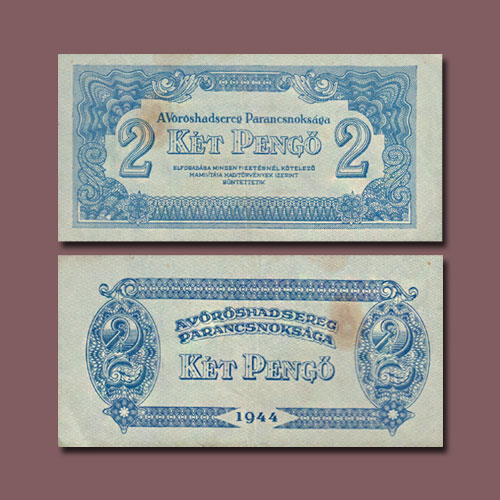Hungary 2 Pengo banknote of 1944
2019-12-11 Wed
Hungary is a landlocked country in Central Europe. Its capital, Budapest, is bisected by the Danube River. Its cityscape is studded with architectural landmarks from Buda’s medieval Castle Hill and grand neoclassical buildings along Pest’s Andrássy Avenue to the 19th-century Chain Bridge.The pengo was the currency of Hungary between 1 January 1927 and 31 July 1946. It was replaced the korona, which in turn was replaced by the forint. The pengo was subdivided into 100 filler. Although the introduction of the pengo was part of a post-World War I stabilisation program, the currency survived for only 20 years and experienced the most serious case of hyperinflation ever recorded. The first series of pengo banknotes were printed in 1926.
During the 2nd World War, in 1944, during the Soviet occupation of Hungary, the Red Army issued paper money without cover in the areas under its control. These banknotes were of poor quality, and aggravated the inflation of the pengo.
Today we are looking at one such banknote issued by the Soviet Red Army. The note depicted beside is a 2 Pengo banknote. This note has the denomination on its obverse with legend in Hungarian reading “Command of the Red Army” and a warning against counterfeiting. Similarly the reverse has the denomination value with Hungarian legend, “Command of the Red Army”.
Image Courtesy: eBay.com
Latest News
-
Mahatma
2024-04-25 ThuIndia Post issued a commemorative postage stamp on #LalaHansraj, also known as Mahatma Hansraj for�...
-
Berar Mint of Muhammad Akbar
2024-04-25 ThuBerar was a kingdom located in the Deccan region, with Elichpur as its capital. It was one of the Su...
-
Janma Kalnayak of Bhagwan Mahavir
2024-04-24 WedOn 21st April 2024 which was the 2550th Janma Kalnyanak of Bhagwan Mahavir Swami, PM Modi unveile...
-
Gold Pagoda of Vijaynagar Empire King Deva Raya I
2024-04-10 WedKing Deva Raya I of the Vijayanagara Empire was a patron of Kannada literature and architecture. He ...
-
Silver Denarius of Septimus Severus
2024-04-05 FriLucius Septimius Severus served as the Roman emperor from 193 to 211 AD. Severus sat on the throne o...

